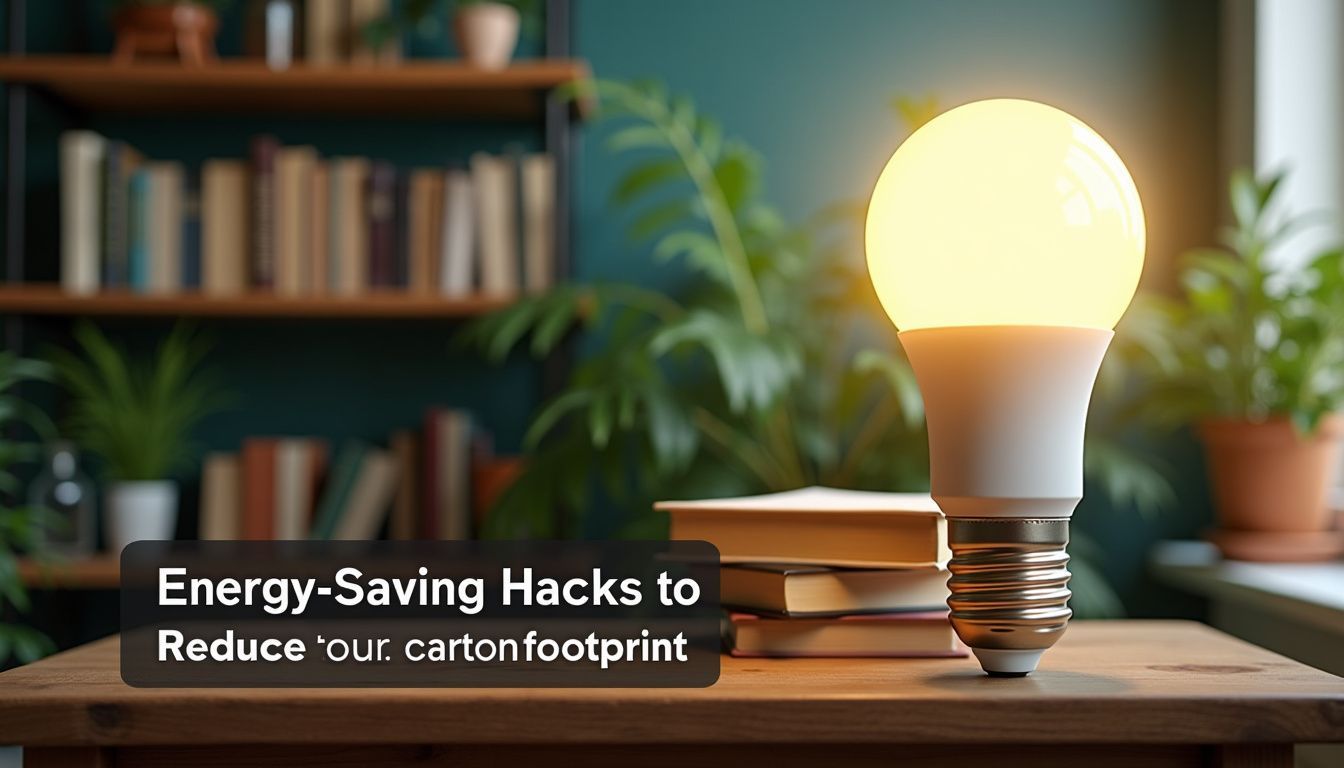Looking to cut down on your energy use? You’re not alone. This article will show you easy ways to save energy and help the planet. Get ready for some smart tips!
Reduce Energy Use at Home

Turning off lights and unplugging appliances when not in use can cut down your energy consumption. Simple acts like these make a big difference. Setting your water heater to 120°F could save around 550 pounds of CO2 each year.
That’s a significant reduction for just one change.
Switching out incandescent bulbs for LED or CFL ones also cuts back on energy use. These bulbs last longer and use less electricity, making them both an economical and eco-friendly choice.
Conducting home energy audits helps identify other areas where you might be using more power than necessary, providing a clear path to further reduce your carbon footprint at home.
Opt for Energy-Efficient Appliances
Swapping out old appliances for energy-efficient models makes a big impact. Look for ENERGY STAR certified products. These items use less electricity and save money on bills. Think fridges, washers, and air conditioners.
Replacing incandescent bulbs with LED or CFL options cuts down energy use too. Consider conducting home energy audits to identify where you can improve. This step guides you in choosing the right eco-friendly appliances for your home.
Energy conservation becomes easier with these smart choices.
Adopt Renewable Energy Sources
Adopting renewable energy sources helps reduce carbon emissions. Solar power, wind energy, and geothermal energy provide clean alternatives. Constellation aims for 100% carbon-free energy by 2040, highlighting the shift toward sustainable energy sources.
These technologies not only lower energy bills but also reduce reliance on fossil fuels.
Homeowners can explore tax credits, rebates, and incentives for making these energy improvements. Investing in renewable energy certificates can also offset carbon footprints. Choosing eco-friendly energy alternatives creates a beneficial situation for both the planet and your wallet.
Improve Home Insulation
Insulating your windows can dramatically reduce energy loss. Use window insulation kits to seal drafts. Weather stripping is a simple way to block cold air. It helps keep your home warm in winter.
Consider conducting a home energy audit. This helps you pinpoint areas needing insulation. Low-flow showerheads can also save water and energy. Proper insulation boosts heating and cooling efficiency.
It’s a smart home improvement for energy conservation.
Adjust Thermostat Settings
Adjusting thermostat settings can greatly reduce energy use. Setting your thermostat to around 68°F in the winter helps conserve energy. Smart home technologies enhance energy efficiency.
Programmable thermostats allow you to set schedules for heating. This means your home stays warm when you need it and cool when you do not.
Wearing sweaters or cozy winter clothing also cuts down on energy consumption. You don’t always need to crank up the heat. This simple change can lower your heating costs while keeping you comfortable.
With these strategies, you contribute to eco-friendly heating in your home.
Utilize Natural Lighting
Natural lighting can cut down your energy use. Turn off lights during the day and let the sun do its job. Smart home technologies can help. They adjust the lights based on the sunlight that comes in.
Use daylight harvesting to brighten your home without using electricity. Adjust your thermostat settings to work well with natural light. This simple switch can lead to big savings on your energy bill.
Embrace this eco-friendly habit for a greener lifestyle.
Conserve Water
Conserving water helps reduce your carbon footprint. A simple adjustment can make a big impact. Setting your water heater to 120°F saves about 550 pounds of CO2 every year. Installing low-flow showerheads also cuts down CO2 emissions, saving around 350 pounds annually.
Homeowners can adopt water conservation practices easily. Conducting home energy audits reveals many water-saving opportunities. Small changes in daily habits can lead to significant savings.
Embrace resource conservation and contribute to sustainable water management.
Minimize Car Usage
Reducing vehicle usage can make a big difference. Drive less and save fuel. Smooth driving habits also help. Maintain your car regularly. It keeps your vehicle efficient and extends its life.
Explore carpooling options with friends or coworkers. Sharing rides cuts down on how often you drive. Use cruise control on highways to save gas. You can also limit air conditioning.
It helps your engine run better. Consider using hybrid or electric vehicles. They lower carbon emissions. Combine errands into one trip. This reduces the frequency of driving.
Choose Sustainable Transportation
Sustainable transportation choices significantly cut down vehicle emissions. Drive less whenever possible. Smooth driving and regular car maintenance can also help your car run efficiently.
Carpooling with friends can save money and reduce the number of cars on the road. Use cruise control to maintain a steady speed and minimize air conditioning to ease fuel consumption.
Explore hybrid or electric vehicles. These options greatly reduce harmful emissions. Choose nonstop flights. They consume less fuel compared to those with multiple takeoffs and landings.
Pursue eco-friendly transportation, and embrace low carbon footprint travel. Every small change counts toward a cleaner planet.
Reduce Food Waste
Reducing food waste starts with small changes at home. Each year, millions of tons of food end up in landfills. This waste contributes significantly to greenhouse gas emissions. Composting organic waste helps lessen this problem.
Many cities, like New York, offer compost drop-off sites. You can also create your own compost pile. Reusable products can further reduce waste. Using cloth bags instead of plastic ones makes a difference.
Embrace food conservation and make every meal count. These eco-friendly practices benefit the environment and save money.
Eat a Plant-Based Diet
Eating a plant-based diet can make a significant difference in your carbon footprint. Livestock farming contributes to 14.5% of global greenhouse gas emissions. By reducing meat and dairy consumption, you can cut your carbon output by about 8 pounds a day.
That adds up to around 2,920 pounds a year.
Plant-based eating focuses on foods lower on the food chain. This type of diet helps the environment and promotes better health. It embraces fruits, vegetables, grains, nuts, and legumes.
Sustainable eating leads to a lower environmental impact. Join the movement and see how eating less meat can benefit both you and the planet.
Shop Responsibly
Shopping responsibly makes a real difference. Choosing sustainable shopping helps reduce waste. Fast fashion contributes to 80 pounds of clothing being tossed by each American each year.
About 85% of that ends up in landfills. Opt for vintage or recycled clothing instead. Thrift store shopping is a smart move. Use reusable bags to cut down on plastic waste. Support eco-friendly fashion brands.
This way, you become a conscious consumer and promote green fashion. Embrace slow fashion and get creative with upcycled fashion choices. Your choices matter.
Support Eco-Friendly Companies
Supporting eco-friendly companies helps the planet. These businesses focus on the environment and sustainability. Constellation aims for 100% carbon-free energy by 2040. Companies like Myclimate fund projects, such as energy-efficient cookstoves in Rwanda.
Terrapass invests in renewable energy projects. They utilize animal waste and wind power. Choose to support carbon-neutral companies and green businesses. Your choices matter. They contribute to a cleaner, healthier world.
Engage in Local Environmental Initiatives
Engaging in local environmental initiatives makes a big difference. You can join local climate action groups and discuss climate change with your community. Get involved in campaigns and vote.
Contact your representatives to push for better environmental policies. Supporting renewable energy projects boosts green energy. Participate in climate marches to show your support.
Vote for officials who prioritize climate action and sustainability. Every small effort counts toward climate change discussions and conservation efforts. Your voice matters in these critical conversations.






